Breeding Better Guide Dogs
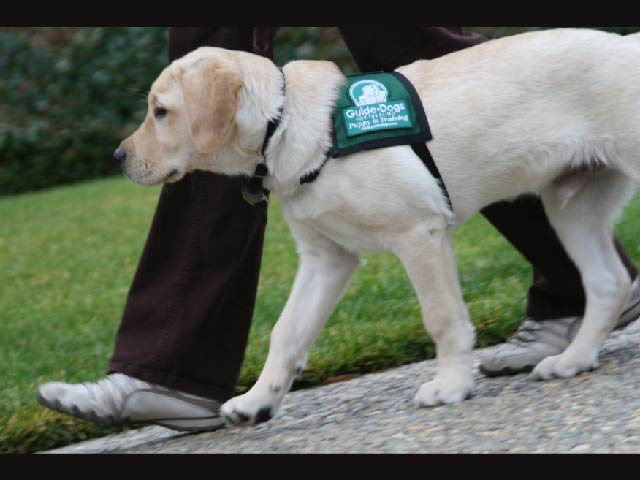
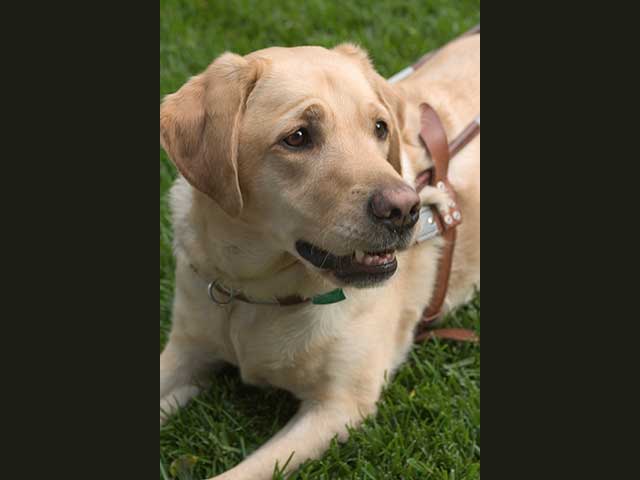
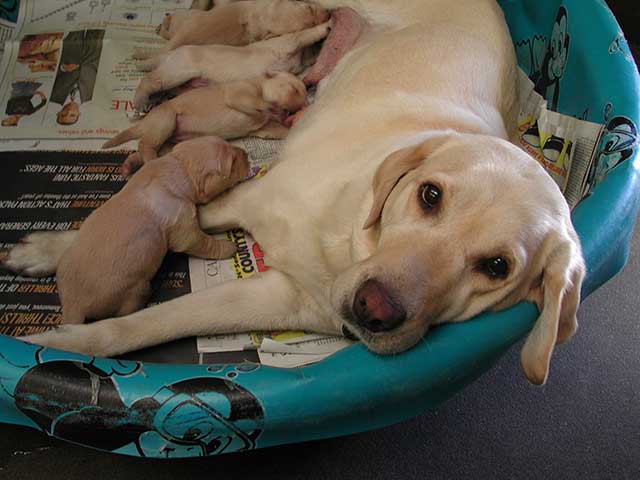
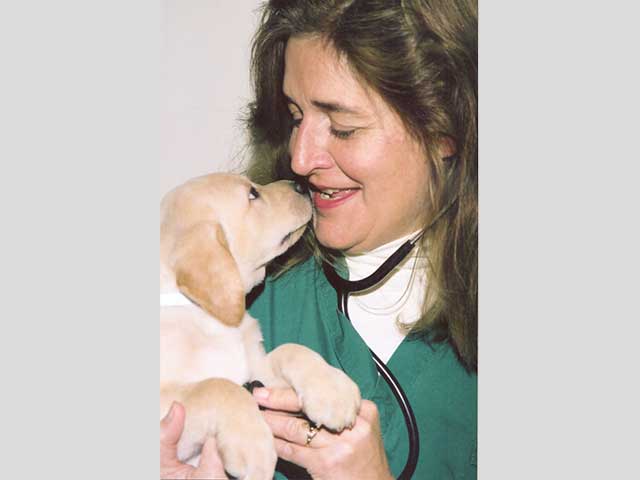
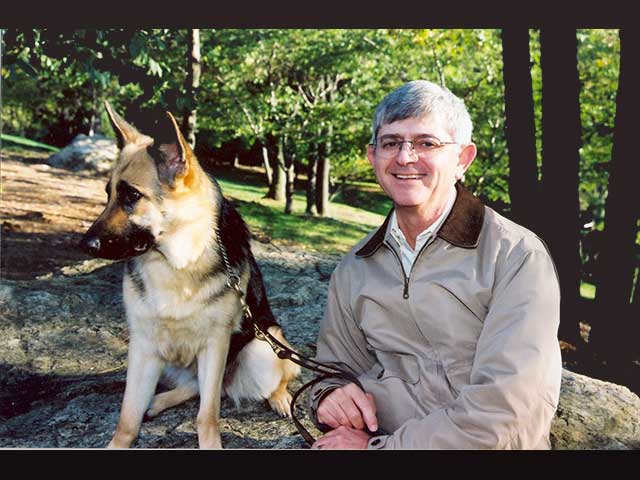
Those German Shepherds or Labrador Retrievers you see in guide harnesses are the products of intense breeding selection, followed by a constant focus on their most minute characteristics and behavioral tendencies. About half of all puppies bred to be guides do not make it beyond the first few weeks of training, and are re-directed into another "career."
Behind the scenes, guide schools employ geneticists who look for sources of health and temperament traits. Statisticians analyze data with powerful computers to determine trends in guide dog populations. Inspired by passion, and a belief in guide work, thousands of volunteers invite guide-dog puppies into their lives, immersing the puppies in all kinds of situations – sitting in quiet offices, maneuvering through bustling city centers, navigating stairs and escalators, or flying in an airplane.
Even more, guide dogs are carefully chosen as a perfect match for the person holding the leash.
Breeding and Genetics
To succeed, guide schools need control over what happens with their dogs from one generation to the next. They accomplish this by maintaining breeding colonies.
Dolores Holle has been the attending veterinarian and director of canine health management at The Seeing Eye, in Morristown, NJ, for 17 years. She describes breeding colonies as "Disney for Dogs. We select dogs for breeding. There's socialization, where they do canine excellence tests and earn Canine Good Citizen certifications. They do agility and clicker tricks. At four weeks, they go into a puppy playroom where we simulate real-world sensations like riding in a car or running up and down stairs. Like children, they have play sets."
It sounds like fun, but serious work is going on to assess which dogs are fittest for guide work, physically and temperamentally. From an early age, experts test each puppy's elbows and hips, and track which parents produce the healthiest offspring. Marina Hall directs the breeding program and labor and delivery kennel at Guide Dogs for the Blind, in San Rafael, CA. "We're always doing colony reviews, to see which females should breed next season, and which ones we'll no longer breed."
Guide schools often breed hundreds of puppies each year. Even after the puppies leave the breeding program and head out into the homes of trainers, socializers, and eventually clients, guide schools continue to track them. As Ms. Hall explains, "We see what kind of temperament and behavior they have throughout their lives. That way, we constantly determine which mothers and studs produce traits we want and whether to continue giving them a role in our program."
Cathy Chenoweth has been a puppy raiser for Guide Dogs for the Blind for 30 years, since she was 11 years old. She gets the puppies after they leave the breeding colony, and prepares them for the real world. She has seen many improvements since she began doing this work. "These dogs have become more healthy. A larger percentage of the dogs have just what we're looking for in guides. They are just getting to be better dogs."
Gwen Gillispie is the breeding manager at Southeastern Guide Dogs in Palmetto, FL, where she has worked for 20 years. "Sometimes, we want to change a particular quality. A lot of guide dogs are what some call 'soft' – they are not bullheaded – so if we want a stronger personality we can breed that up. It might take a couple of years, but we can do it." Ms. Gillispie says that with careful monitoring, generation after generation, guide schools know how to mix and match parents to get the traits they need.
Breeding up particular personalities takes place slowly, subtly, over time. The changes are clearer in the incidence of health issues. Dr. Eldin Leighton has been a geneticist at The Seeing Eye since 1977. "Genetically, we have focused our attention on two major traits. One is hip quality. Dogs with bad hips will not be good guide dogs. The second is behavior, or what we call trainability. In 1980, about 30% of the German Shepherds failed out because of hip displasia. That has now dropped to about 3%."
Jane Russenberger, senior director of breeding at Guiding Eyes for the Blind in Patterson, NY, has seen similar success in the Labrador Retrievers her agency breeds. "In the general Lab population, incidence of hip displasia is about 20%. In our population, it's down to about 2%."
Other guide schools report similar successes with eye and ear diseases, and skin problems.
Success comes in part from sheer numbers. As Ms. Russenberger explains, working with so many dogs allows guide schools to take an already successful idea to higher levels. "If you think about most breeders, they spend a lifetime practicing their art, whether they are making herding dogs or show dogs. But they just don't have the opportunity to keep the best dogs out of a very large number of great dogs. We can watch all our dogs, and just choose the best two or three for breeding."
It is not just that guide dogs are healthier. They have begun to look different. The guide schools that breed German Shepherds describe a different body type that emerged from the specialized breeding, one more suited to the demands of guide work. "When you see one of these dogs," Ms. Holle explains, "right away you can see a very straight top line, which has been bred away from in the show dogs. To a certain degree, we're creating a subset of a breed."
Intersection of Genetics and Environment
With all their measurable accomplishments of the past 30 years, guide school also rely on the art of interpreting the hazy mix of genetics and environment. As Ms. Holle says, "We're still always trying to sort out what's genetic and what's training. At any time, we have 800 volunteers out there training dogs in all kinds of environments. Puppy raising still makes or breaks a guide dog."
As Ms. Russenberger says, "Hip displasia is black or white. Does the dog have it or not? But when we talk about temperament, we're looking at a whole set of traits coming together."
Moving out of the realm of pure science, Ms. Chenoweth describes her mission as a guide-dog puppy raiser this way: "The basic characteristics we need are confidence, adaptability, trainability, and love."
Thinking back on 30 years of close acquaintance with numerous successful guides, Ms. Chenoweth says, "When I started, I'd see dogs that were unruly and difficult to train. We just don't see that any more. The success rates are going up, because the dogs are more confident." That success has to do with the sophistication of breeding colonies, where the guide schools have been able to observe the body and mind of the guide dog.
The dogs have also started to show a wider variety of personalities. "In the past, the dogs were in three categories: shy, very middle-of-the-road, or hyper-crazy. We still have those types, but there's more variation within them," Ms. Chenoweth explains.
This variety means guide schools can match guide dogs with specific people, based on personality and lifestyle. Maybe the person is a high-energy sales rep and needs a dog that can be constantly on the move, or maybe that person works in an office and needs a guide to be sedentary for long periods.
Matching the dog to the person can get even more precise. In fact, many trainers are adept at reading subtle cues in people's personalities. "Some people need a softer dog, who obeys commands easily," Ms. Gillispie says. "Others need a more stubborn dog."
Why would someone need a stubborn dog? By nature, some people get themselves into trouble. Perhaps they are accident prone, or live in a confusing environment. "They need the dog to decipher the situation and determine independently if a command is going to get them into trouble and whether to disobey or not," Ms. Gillispie explains.
To make these matches, trainers are mindful of traits on the human and dog side. That might be why Ms. Hall earned a degree in animal science, with a minor in psychology. "We look at which dogs, and which people, have higher stress thresholds, energy levels, attention-seeking levels, and problem-solving skills."
This kind of super-specialization is intensifying as guide schools learn more about physical and temperamental traits, and how to control it in breeding and training. This puts increased pressure on the dogs. "We have an internal competition," Ms. Hall says. "Only the top dogs in the class, with the best aptitude, are selected to produce the next generation. Winners produce winners. We try not to tell the dogs about it! But they are always weighed against each other."
Multiplying Their Knowledge
Adding even more to the power of their high breeding numbers, guide schools have begun sharing their knowledge with each other, creating a multiplier effect.
In the 1990s, many guide schools began realizing that, although their dogs were succeeding, they were beginning to experience a statistical problem. It stems from the way guide schools measure each generation's suitability for guide work. As Dr. Leighton explains, "We use a 'trainability score.' It's a nine-point scale, kind of like grading kids in a classroom. Each generation, we compare the dogs to previous ones who came through the system. The best dogs are in the 90th percentile, the next best in the 80th, and so on. We know that dogs that score under 6 have almost no chance of making it as guides."
This is effective. However, as the number of tested traits grew, it became difficult to compare across generations of dogs. Guide schools realized they were doing long-term tracking with a moving target. "That's where better statistics can help," Dr. Leighton explains.
To provide those statistics, in 1993 The Seeing Eye turned to Dr. James Serpell, who manages the Center for the Interaction of Animals and Society at the University of Pennsylvania and has over 20 years of experience researching canine behavior. In addition to what he calls the problem of "the moving goal posts," Dr. Serpell adds that each school had a different kind of assessment. "There was no consistency," he explains, "and because the schools generally stop breeding half the dogs in their breeding program, they were constantly shifting what they were looking for and could not determine if they were moving in the right direction. We came up with standardized measures schools can use to compare each generation during training."
After working with The Seeing Eye for a short time, Dr. Serpell's program attracted the attention of four other guide schools. All five schools now have a consortium. They all use the standard assessments and share their breeding and training information. The schools are able to use the findings to go even further towards creating dogs with honed, specialized temperaments.
Guide Dogs and Society, Changing Together
Guide schools have traditionally served sight-impaired people. As the abilities of the dogs improves, and schools develop better assessments of canine traits, the future holds very interesting possibilities. Using "forecasting," the schools assess how society is changing and presenting new needs, and how guide dogs could help more people.
Looking forward, Ms. Chenoweth, who has been involved in forecasting, says, "More guide dogs will have to be good at dealing with busier city atmospheres with lots of activity and stress. The dogs will need better stamina. They will need to be more flexible and alert, even more so than what we normally have looked for."
Moving beyond the traditional guide-school clients, Ms. Hall says, "We're seeing more people with multiple disabilities besides visual impairments. We're also seeing older clients now. That's changing the demands, so we have to keep changing the kinds of dogs we breed."
Ms. Gillispie, who works mainly with clients in Florida, has seen a turnaround in the age of her clients, from an elderly to a younger audience. "The older clients needed a slower dog that did not pull much," she explains. "With younger clients, we're needing faster-moving dogs."
As guide-dog trainers work to keep up with a changing society, Dr. Serpell says the five-school cooperation will be more essential. "The end point is not static. Things are shifting all the time. The guide schools need to be able to look back and assess how they have done over time, so they can be sure they are getting better. Without the data, it's just guesswork."
No matter where guide work goes in the future, and no matter how much science becomes part of it, there will always be mysteries of behavior and temperament.
And the dogs will always be dogs. As Ms. Holle says, "What makes these dogs really special is their ability to bond so well with humans."
